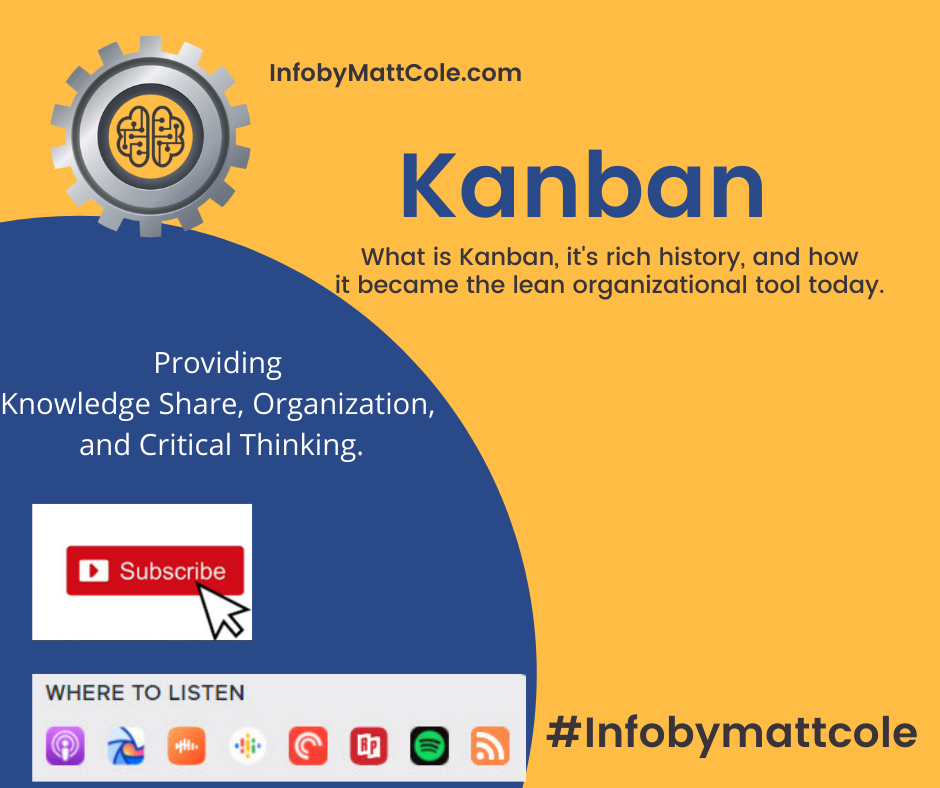Kanban in Japanese means sign or large visual board. Today, this would be our billboards when considering the word Kanban.
Kanbans refer to the cards being utilized within the Kanban System. These cards were used to help control work in progress, sometimes referred to as Kanban boards.
Today we would define Kanban as a method for defining, managing, and improving services that deliver knowledge work. A knowledge worker is a profession that primarily involves producing unique knowledge such as decisions, analysis, problem-solving, theory, strategy, planning, design, art, and technology.
Kanban is characterized as a start, ‘what do you know method’. The idea is to make visual what would otherwise be intangible or not have a physical presence. This is why it was utilized within the knowledge work area.
Proper use of Kanban is to identify the right amount of work, ensure the service works and that service is delivered. This is done by using visual signals (ie kanban cards) to help enforce the delivery flow system limiting the amount of work in progress. In other words, it is used as a means to guide efficiency in your workflow.
A typical and simple Kanban board is a physical board divided into three vertical columns. Normally the three columns are identified as “To Do”, “Doing”, and “Done.” These same three terms to identify the columns or three stages are also titled “Requested”, “In Progress”, and “Done”.
Teams or individuals would identify what needs to be done and apply those tasks onto sticky notes. These would then be placed onto the board. These sticky notes, beginning in the To-Do column would then be moved through the Doing column, upon completion enter the Done column. This would allow each request within the To-Do column to be known, prioritized, and chosen to move forward. This is a visual way to quickly see the workflow and demonstrate progress.
Today, within the workforce, we see this same concept as opening a ticket for the request, having that request prioritized, assigned to an analyst, who will work on it until completion. The digital ticket system represents the visual kanban board, allowing all to view the progress. The three primary steps remain the same. “To Do” is the ticket being opened as a request. “Doing” is the ticket having an assigned analyst, when the work starts. “Done” is when the work is complete, and the ticket is closed with a resolution or complete build.
Parents have also used this same Kanban system without realizing it with their children. By having a whiteboard and assigning small jobs to their children, they utilize a visual board or Kanban Board. The family sees all that needs to be done in one location. While the parent may not physically be moving the task to visually represent the work in progress, they will be asking “if it is done” (Done stage). Meaning, are you working on it (Doing or In Progress stage).
Now that we covered the Kanban task, let’s move on to the history and how this lean management methodology was introduced to America.
You can find my Podcast on all the platforms above! Be sure to subscribe to Info By Matt Cole Podcast on your favorite platform!
Be sure to subscribe to my YouTube channel where more content and educational videos can be found.
History
The use of Kanban or visual boards came on Japan’s scene in 1603. After an end of military conflicts and social upheaval, Japan entered into a period of stability and economic growth. This provided safe crowds in Japan’s streets, giving way for merchants to begin selling while the economy flourished. Having to gain customer awareness and attention from other merchants, Kanban was born.
The term Kanban is a merge of two words “Kan” meaning sign and “Ban” meaning board.
As the streets began to be filled with would-be customers, shop owners would begin to make elaborate signs to draw attention to their stores. The more elaborate and unique to make it stand out, the better. The purpose was to provide visually a clear and concise message identifying the content to the audience.
Moving ahead, in the 1940s after the second world war, the Japanese car industry Toyota was in stagnation. Having a continual loss, unable to compete with American car manufacturers, they were in trouble. Then CEO of Toyota Kiichiro Toyoda was on a mission to turn this around and began the quest to equalize his company’s productivity with then American car manufacturers’ productivity in three years. An ambitious goal. This changed the company’s culture, allowing for a young industrial engineer named Taiichi Ono to rise in the ranks at Toyota.
Transferring to the company in 1943, Taiichi became shop manager by 1949 where he began experimenting with new tools and principles involving work organization. By 1954 he was promoted to a director position.
Taiichi Ono identified seven kinds of waste, leading to a decrease in performance and workflow inefficiency. This led to the concept “produce what is needed and only when it is needed.” Once this was understood, the next issue was how to properly communicate between each area? How do you properly signal between the suppliers, production line, and when a new product is required?
Visiting the United States in 1956, Taiichi Ono was impressed by how the supermarket chain Piggly Wiggly was able to properly keep their shelves stocked. Returning home he began to use paper cards to identify and communicate and track throughout his factory, naming the system Kanban.
A Kanban card would be attached to every finished product. Once that product was sold, it would return to the front of the production line. These cards would be used to track progress through the production line. A team member could not touch the product until the prior task was complete and the card was marked accordingly. Additionally, the team member(s) may not work on the product(s) in motion until a number or threshold of those items were ready. This means they were also batch working.
This type of system in play reduced stockpiles, improved workflow, and provided a visual in the actual process. Having this system working, it was pushed and utilized with the whole company in 1963. This Kanban system is what turned a losing company into the powerhouse we see today with Toyota. Turning the company around also pushed Taiichi Ono up through the ranks to come executive vice president in 1975. His use of the Kanban system changed how the visual boards were viewed laying down the foundation for modern management techniques. known as Toyota Production Systems.
Being so productive other project managers from different industries attempted to use the core teachings and adapt them to their own industry. The utilization found a new home in the software industry.
The software industry was in the same situation as Toyota had been after world war II. The parallel is eerie. Inefficient, cumbersome, it needed to find a better method. Just as Toyota, a change in culture occurred in the software industry sparked by the Agile Manifesto creation. The manifesto’s underlying principles included welcoming requirement change and increase delivery for working software.
This culture change with the new acceptance brought us the Agile software we see today, such as Scrum, Extreme Programming, and Lean Software Development.
This same Agile software tenents would in turn significantly impact the Kanban System, turning it into today’s Kanban Method.
In 2007 David Anderson was trying to find a better method for workflow and with his like for Toyota’s Kanban System, he left Microsoft and moved to Corbis, with a mission to change Corbi’s engineering and improve productivity. There, together with Dominica DeGrandis, he introduced a Kanban system for change requests processing. It has freed the team from constraints of time-boxed iterations, allowing them to reduce work in progress, and balance capacity against demand
Other companies that were using Scrum boards, soon modified them to introduce columns representing three distinct stages of work, converting Scrum boards to Kanban boards. Soon the software industry began using the Kanban method, a term David Anderson used in 2007.
Today the Kanban Method has been transfigured and condensed to the Kanban System by utilizing five practices.
Visualize Workflow
Limit Work in Progress
Measure and Manage Flow
Make process policies explicit
Use Models to recognize process improvement opportunities.

Matt Cole has high regard for knowledge share. He has a desire to share critical thinking and information. With a Masters in Information Technology and a wide array of certifications, while not working full-time, he wishes to knowledge share through providing insight, information organization, and critical thinking skills.
#KnowledgeShare | Matt Cole | #infobyMattCole




